Britain’s test and trace failure: Official data shows a THIRD of Covid-infected Brits refused to give details of contacts or couldn’t be tracked down as head of flagship scheme Baroness Dido Harding admits it’s ‘not at the gold standard yet’
- 8,117 people who tested positive were referred to the NHS’s flagship scheme
- But contact tracers could only get information from 67 per cent of them (5,407)
- Data shows that 45 new cases of Covid-19 appeared during trial of the NHS app
- But since the initial trial of the app ended, only two more positive cases found
- Here’s how to help people impacted by Covid-19
Britain’s test and trace fiasco deepened again today after damning figures showed Number 10’s flagship system has only tracked down the contacts of two thirds of Covid-19 patients.
Between May 28 and June 3, 8,117 people who tested positive for the coronavirus were referred to the NHS’s flagship scheme. But shocking statistics show contact tracers could only get information from 67 per cent of them (5,407).
Hundreds did not respond to phone calls or refused to give details of people they had been in contact with, the Department of Health admitted in another blow to the scheme that has been described as ‘shambolic’ by workers.
Baroness Dido Harding — the head of the test and trace scheme — today admitted it wasn’t yet ‘at the gold standard we want to be’. She added: ‘Is it completely perfect? No, of course it isn’t.’
She explained: ‘We won’t have got all of the contacts. Some were unreachable, some didn’t want to provide contacts, some said “well, I’ve already told my mates I tested positive”.’
The data comes as feedback from the Isle of Wight suggested that the NHS‘s long-awaited coronavirus contact tracing app — which has yet to be rolled-out — could be an effective way to stop the spread of the disease.
Just two new cases of the illness have been discovered on the island since the app’s initial trial ended on May 26 — a noticeable drop on the 45 cases spotted during the trial, suggesting it stopped patients from infecting other people.
Health Secretary Matt Hancock previously promised the app, then considered a vital part of the government’s test and trace strategy, would be ready to be rolled out across the UK by the middle of May.
He claimed today that the test and trace system is ‘already helping to stop the spread of the virus’. The Health Secretary added the system was ‘key to helping us to return to a more normal way of life.’
But repeated delays have meant the app — now considered the cherry on top of the cake — is still unavailable anywhere except the Isle of Wight.
Staff paid up to £27-an-hour to ring contacts of infected patients have described the test and trace scheme as ‘shambolic’, with call handlers warning the system was ‘obviously not ready’ when it was launched in England at the end of May.
In the first week of the service, 26,985 contacts were successfully reached by someone on the army of 25,000 tracers, meaning the staff, on average, only contacted one person each for the whole week.
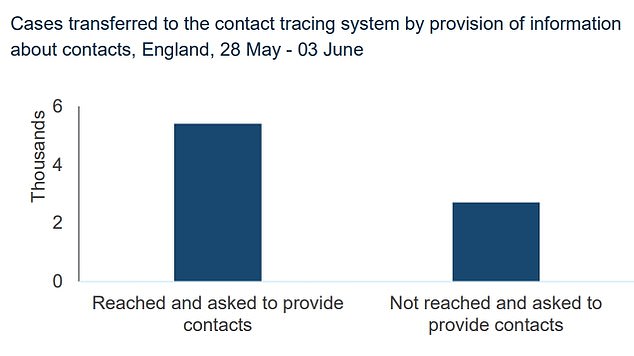
Between May 28 and June 3, 8,117 people who tested positive for the coronavirus were referred to the NHS’s flagship scheme. But shocking statistics show contact tracers could only get information from 67 per cent of them (5,407)
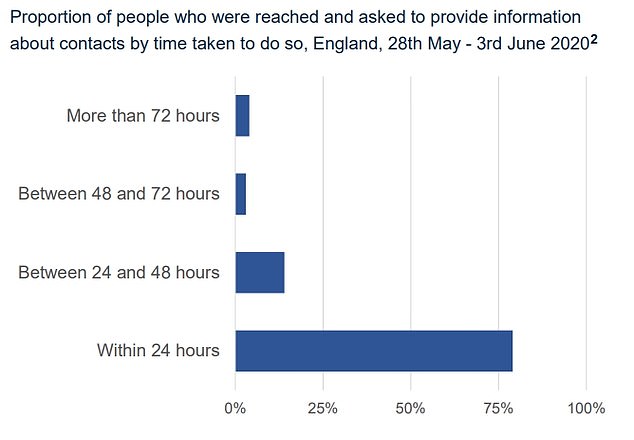
Of those people who were reached and asked to provide information about their contacts, just over three-quarters (79 per cent) were contacted within 24 hours of their case being transferred to the Test and Trace system. Some 14 per cent were contacted between 24 and 48 hours, 3 per cent between 48 and 72 hours, and 4 per cent were contacted after 72 hours
The nationwide test and trace figures, released by the Department of Health this afternoon, cover the period between May 28 and June 3.
Overall 31,794 contacts were identified — the equivalent of almost six (5.8) for every infected patient. Only 26,985 of these contacts — 85 per cent — were successfully tracked down and advised to self-isolate, the statistics revealed.
The programme said the number of people reached includes those who provided details about recent contacts or whose cases have been investigated as part of an outbreak.
The number that were not reached includes those where contact details were unavailable or incorrect, or where there has been no response to text, email and call reminders. It also includes people who the service has been able to contact but who refused to hand over details of their contacts.
Contact tracers try 10 times to reach someone in the first 24 hours after they have been referred to the service, attempting to get through to them by email, phone and text.
Of those people who were reached and asked to provide information about their contacts, just over three-quarters (79 per cent) were contacted within 24 hours of their case being transferred to the Test and Trace system.
Some 14 per cent were contacted between 24 and 48 hours, three per cent between 48 and 72 hours, and four per cent were contacted after 72 hours.
Finding people fast is vital for the system to work because the plan is for it to find potentially-infected people before they start to show symptoms and pass the virus on to other people.
Jonathan Ashworth, Labour’s Shadow Health Secretary, said: ‘Tracing is vital to the safe easing of lockdown.
‘Though this is early data, Matt Hancock needs to explain at this evening’s press conference why a third of people don’t appear to have been contacted and what action they will take to rectify this.’
Professor Keith Neal, an epidemiologist at the University of Nottingham, said: ‘Being unable to contact 33 per cent of diagnosed cases is a concern particularly as a mobile number is involved in requesting the test.
‘Some of these are part of other investigations including those related to care facilities – this data should be obtainable and identifiable. Nearly 80 per cent of those reached were contacted in a timely manner.
‘An absolutely crucial part of the test and trace system is the public committing to it – the system can not work without the public’s involvement.’
Baroness Harding — who was chief executive of TalkTalk when it was rocked by a huge cyber attack in 2015 — today admitted the system was not yet where she wanted it to be.
She said: ‘We are not at the gold standard yet that we want to be, of isolating all contacts within 48 hours of someone requesting a test. But you can absolutely see the path of how we are going to get there.’
And she claimed the programme was ‘where we said we would be, which is we have a functioning service’, adding that it was ‘fit for purpose’ now and would continue to improve.
Baroness Harding said: Just as the infection rate is coming down in the country, so is our capability to test and trace growing. We have got real scale — this is a national-level service that has stood up in extraordinary time.
‘Is it completely perfect? No, of course it isn’t. Is there stuff that we all need to do better? Yes there is. But I think it’s fit for purpose as we stand today and will get better through the summer.’
Baroness Harding also said the ‘vast majority’ of people wanted to play their part in the test and trace system. But she was unable to say how many people contacted and told to self-isolate had refused to comply with the request.
She said: ‘This is not a mandatory process. I am a really firm believer in the good spirit and civic behaviour of the public and we have seen the public be extremely responsive and supportive.
‘These are very good numbers for compliance and we want to encourage people to be part of the system rather than have them be fearful about what might happen to them as they go through it. The wonderful thing about the first week is that’s what we have seen.’
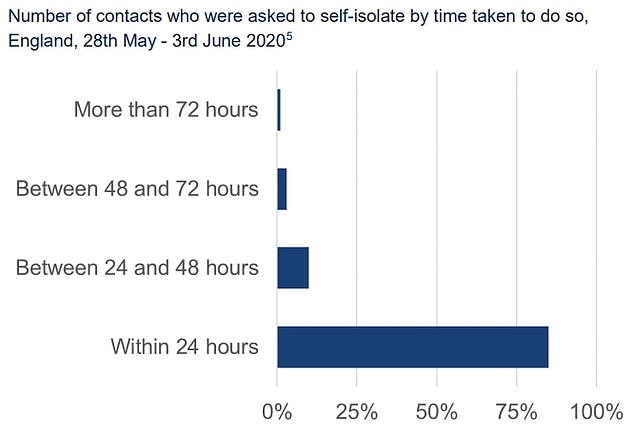
The Department of Health said 79 per cent of contacts of confirmed Covid-19 cases were reached within 24 hours and told to self-isolate
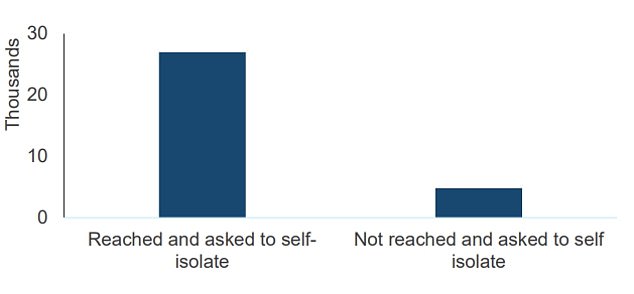
Statistics show that 26,985 out of a total 31,794 potentially-infected people were successfully contacted by NHS tracers
Baroness Harding was also unable to give a date for the launch of the app which will form part of the test and trace programme she leads.
She said: ‘This is a multi-channel consumer service, it’s online, it’s on the phone, it’s face-to-face in local communities and, in time, it will have an app.
‘The app “is the cherry on the cake, it’s not the cake itself and what you are seeing today is the first baking of the cake is going reasonably well”.’
The number of people who were referred to the contact tracing system between May 28 and June 3 is significantly lower than the number of new positive tests announced by the Government during that time – 8,117 compared to 13,417.
In a briefing this afternoon Baroness Harding and Professor John Newton, director of health improvement at PHE, said this was mostly a problem with the testing figures.
Professor Newton said: ‘There’s quite a lot of double counting in the numbers of positive tests that are reported daily.
‘We are very confident that the 8,000 includes a very high proportion of the new cases.
‘Of course, there will be new cases in the community who haven’t had a test but we are confident that we have included all the people who have tested positive.’
Baroness Harding added that some of the positive tests announced by the Department of Health come from anonymous surveys, and there were also inaccuracies in both sets of data which would be ironed out over time.
When faced with concerns that contact tracers weren’t doing enough work, averaging fewer than 1.1 contacts each in the first week, officials said having too many was better than having too few.
Baroness Harding said: ‘We certainly have significant over-capacity in both testing and tracing but I’m not going to apologise… we will, over time, need the capacity as we head towards winter.’
‘I’d rather it was this way round,’ she added.
Matt Hancock and Professor John Newton, a medical director at PHE, also said they were happy with how the service has gone so far.
Mr Hancock said in the House of Commons today: ‘NHS Test and Trace is a new service on a scale never seen before, designed to help us control and contain this virus, and save lives.
‘Backed by our rapid expansion of testing across the country, the new data shows how we are already helping to stop the spread of the virus with thousands of people booking a test, isolating and sharing their recent close contacts.
‘The service is key to helping us to return to a more normal way of life.
‘We need everyone’s support and collaboration to ensure that we can continue to keep infections falling.’
Professor Newton said the Government was seeing ‘high levels of compliance both from cases and contacts’, and added: ‘In general we’re very pleased to see these data… We’re quite confident that what we’re doing is having a big impact.’
Data from the Isle of Wight shows that the app came at a time when the island was experiencing a surge in cases.
Having recorded only 154 coronavirus cases by May 7, the community then saw a 31 per cent surge in new cases when 45 were found in a month.
This outstripped the national outbreak in England, which grew by only 12 per cent in the same time, The Times reported.
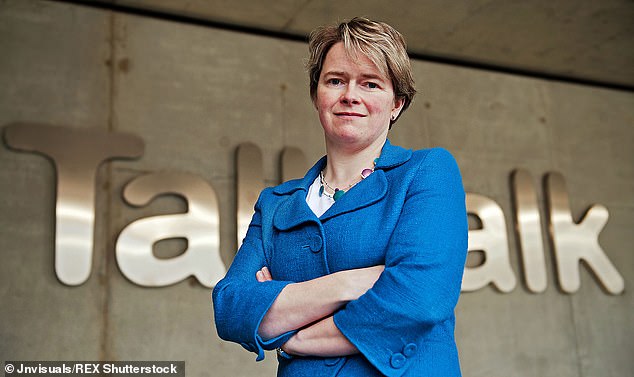
Baroness Dido Harding — the head of the test and trace scheme — today admitted it wasn’t yet ‘at the gold standard we want to be’. She added: ‘Is it completely perfect? No, of course it isn’t’
This could be a sign that the app and testing contacts of confirmed cases had detected considerably more cases of the virus than were being diagnosed beforehand.
But the unique conditions on the island, and the fact that the population and number of new cases were so small, make it difficult to know whether it was the app and contact tracing that helped.
Being on an island gives the community there natural protection, especially at a time when people were not supposed to travel there from the mainland, meaning fewer cases of the illness were carried there by outsiders.
And a small population meant it would be easier for people to get tested.
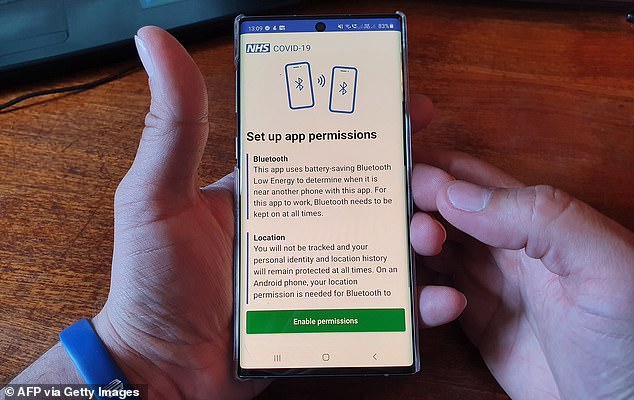
The NHS app is considered a vital part of the Government’s ‘test, track, trace’ programme for stopping a second wave of coronavirus infections in Britain
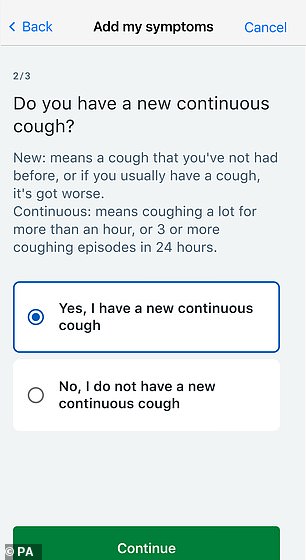
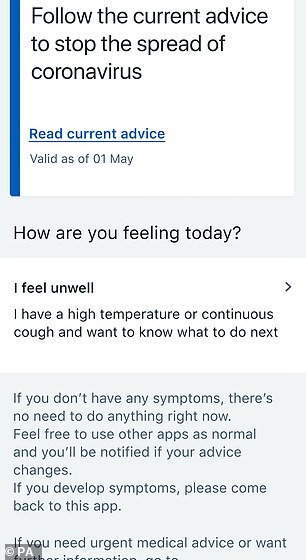
The NHS app, which is currently only available on the Isle of Wight, will rely on people accurately reporting whether they are ill or not, or have tested positive. Contacts will be advised to self-isolate while someone is tested
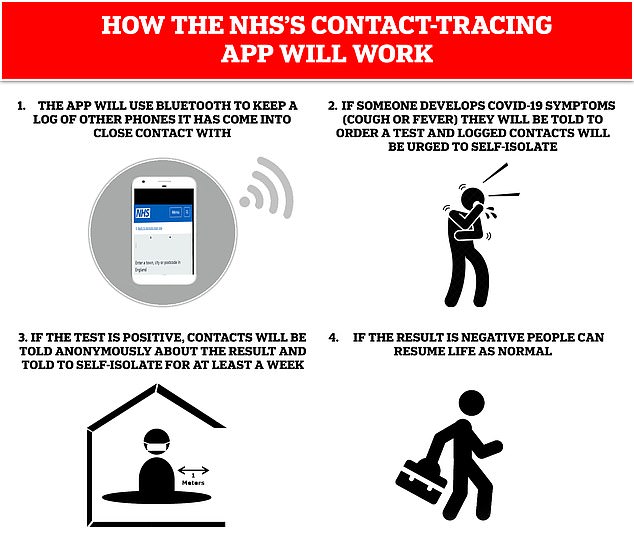
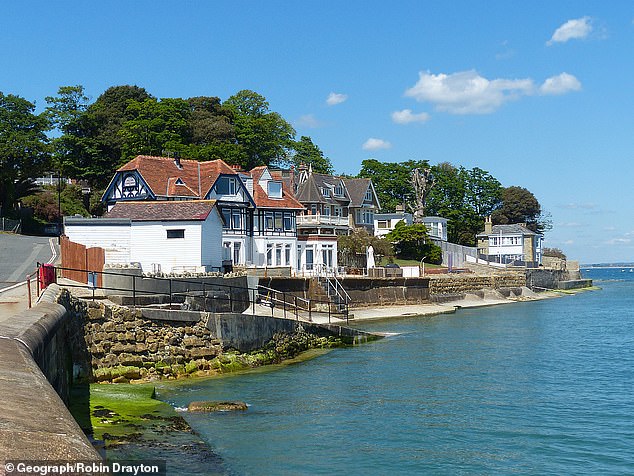
The Isle of Wight was chosen as the location for the NHS app trial because it is a self-contained island so the population was easy to monitor (Pictured: The village of Seaview on the island)
Professor Paul Hunter, a medicine lecturer at the University of East Anglia, told The Times: ‘It is very hard to draw a definitive conclusion because the overall case numbers on the island are small which makes it hard to prove in a statistically significant way… But it does look promising.’
Officials in the Government are said to be toning down their enthusiasm for the app, which was hailed as all-singing all-dancing in its early development stages.
There are concerns that, although it seemed to work well on the sparsely-populated Isle of Wight, it may not be effective in busier areas and urban tower blocks.
London’s deputy mayor for fire & resilience, Fiona Twycross, said at a meeting of the London Assembly: ‘We can all imagine what will happen if you have a tower block where you are reliant on Bluetooth.
‘You might get inaccurate readings from people who haven’t actually been in contact with people,’ The Independent reported.
The focus may now be shifting towards human contact tracers, The Times reported.
Government officials reportedly said they had been ‘too keen’ to push the app and that actually other countries that have had success have focused on human staff.
One source told the newspaper: ‘That doesn’t mean the app doesn’t have a role to play but it is not a single solution.’
Bob Seely, the Conservative MP for the Isle of Wight, said the results of the trial were promising but ‘need to be studied carefully’.
The NHS Test and Trace programme has been dogged by reports of IT problems and many of the thousands of staff having little or no work to do.
And last week it was reported that hundreds of staff being paid up to £27-per-hour were being let go because there was nothing for them to do.
Health Secretary Matt Hancock admitted yesterday that he still cannot say when the Government’s coronavirus contact-tracing app – the third strand of the project – will be ready to launch.
Mr Hancock told the virtual CogX technology conference that trials of the app have been continuing on the Isle of Wight.
‘The app is progressing and we will launch it when the time is right. I am not going to put a date on it,’ he said.
He said however that persuading people to self-isolate if they had been in contact with someone with the disease was better done by a human contact-tracer.
‘What really matters is the people. The technology is a facilitator for people to be able to do things better,’ he said.
‘Getting people actually used to the idea that if you are contacted by the contact tracer you do that (self-isolate). That is better done with human contact and hence the contact-tracing system that is up and running is working well.’
But while the app has been held up by technical issues, the human contact tracing scheme was also dogged with problems at the outset.
People working in the system, which was supposed to be fully operational by June 1, said at the start of this month that they did not contact anyone in the two weeks after starting work.
And employees said they were having to repeat training because glitches in the system meant they could not register that they had completed it already.
Those keen to get started said they were left twiddling their thumbs and stuck in queues of over 350 people waiting for technical help.
Sent laughing emojis by bosses who couldn’t help them, contact tracers said the system was ‘shambolic’ and unfit for purpose.
There are also concerns test and trace won’t work if Britons refuse to give friends or relatives’ details, and one call handler revealed two of the three potentially infected contacts she rang went straight to voicemail.
One source, who was employed by Sitel from May 13 was still waiting on June 1 to make their first call while earning £75-a-day for doing nothing.
Experts say the success of the project is crucial to banishing the virus from our lives and a 25,000-strong army of ‘test and trace’ call-handlers have been recruited by companies like Sitel and Serco for the task.
The source, who is based in the West Midlands, said: ‘Each day we login and it’s the same thing over and over again. We ask what we are going to be doing today only to be told to hold tight and chill out and, “you’re still getting paid”.’
Who is Dido Harding? Baroness Harding of Winscombe was raised on a farm in Somerset, is former CEO of TalkTalk, an ex-jockey and married to Tory MP for Weston-super-Mare
The former chief executive of TalkTalk, who was at the helm of the company when it was hit by an £80 million cyber attack in 2015, is leading the UK’s test and trace scheme to tackle the coronavirus.
Baroness Dido Harding of Winscombe, 53, was raised on a Somerset pig farm and is the granddaughter of Field Marshall Lord Harding, the commander of the Desert Rats who became the most senior soldier in the British army.
A former jockey, she studied Policy, Politics and Economics at Oxford University, alongside David Cameron, and is the wife of John Penrose, the Conservative MP for Weston-super-Mare.
Upon graduating, she held a slew of roles at Thomas Cook, Woolworths, Tesco and Sainsbury’s.
Baroness Harding was appointed CEO of TalkTalk in 2010, serving in the role for seven years, during which the company was the victim of a cyber attack that saw the personal and banking details of 157,000 customers accessed by hackers.
She was subjected to repeated blackmail attempts after the hack, with demands for Bitcoins in exchange for stolen data, which included customers’ names, email addresses, mobile numbers, home addresses and dates of birth.
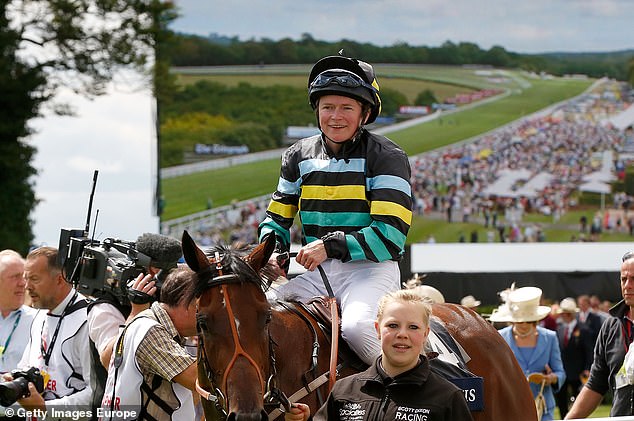
Baroness Harding is a former jockey, though she quit racing after hitting 40 and promising her husband she’d stop
In the aftermath, TalkTalk was fined a record £400,000 for security failings which allowed the data to be accessed ‘with ease’ in one of the biggest data breaches in history.
TalkTalk is thought to have lost £60million from the fallout with an estimated 100,000 angry customers leaving, mainly to BT, while 2015 profits halved to £14million and shares lost nearly two-thirds of their value.
Baroness Harding faced repeated calls to step down over the breach, but stayed on until 2017, when she resigned to focus on her ‘public service activities’.
Later that year, she was appointed chair of NHS Improvement, responsible for overseeing all NHS hospitals.
A powerful figure, she refuses to believe her gender has ever held her back, nor will she endorse female quotas on company boards, which she sees as political meddling.
She also thinks that workers have too much maternity leave, despite admitting being the boss has allowed her to successfully juggle her own career with spending time with the two daughters she has with her husband.
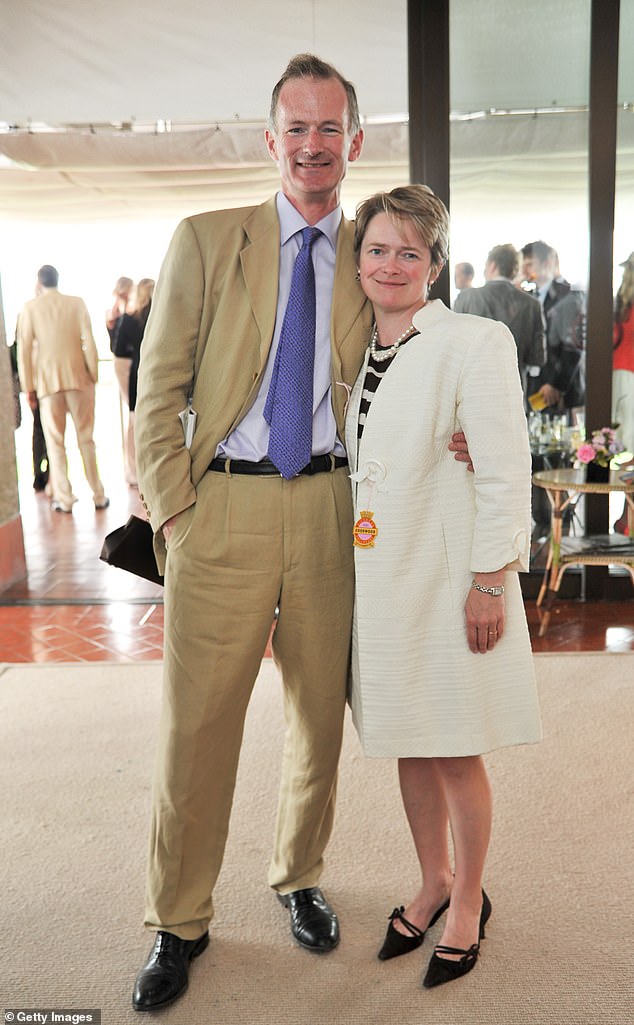
She studied Policy, Politics and Economics at Oxford University, alongside David Cameron, and is married to John Penrose, Conservative MP for Weston-super-Mare
She said in a 2015 interview: ‘I have an enormously privileged position.
‘I make a lot of money – a matter of public record – I have a huge amount of help, and I’m more in control of the day and what I do than someone working shifts on the checkout, or running the produce department in a supermarket.’
Baroness Harding has also packed in a career as a jockey, which saw her appear at Cheltenham, Ascot and even the towering Grand National jumps at Aintree.
One particularly nasty crash over the sticks at Larkhill left her strapped to a spinal board – though she still managed to catch a flight to a conference in Thailand the next day.
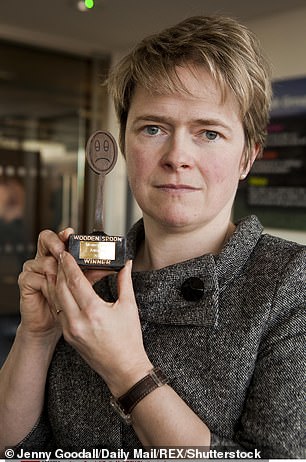
As TalkTalk CEO, she was presented with the Daily Mail wooden spoon award for ‘Worst Customer Service’
But, aged 24, she made a rash promise to her husband – she would give it all up at 40.
When the date came Penrose, who had not forgotten, made it clear breaching the bargain was a deal-breaker for the marriage.
Harding obliged, though does still race without jumps.
‘I miss the racing hugely,’ she previously admitted. ‘If you told me I could go off and do it tomorrow afternoon I would. For me that’s always been my way of shutting everything off and relaxing.’
Now, she is the leader of the government’s coronavirus tracing programme.
The NHS Test and Trace system for England will see anyone who develops symptoms told to self-isolate and get tested, with the close contacts of those who are found to be positive for the disease then told to quarantine for 14 days even if they test negative and are not sick.
The system is being launched without its NHS contact tracing app centrepiece prompting concerns that without the new technology the Government could struggle to tackle the spread of the disease.
Experts immediately said the complexity of the programme meant there could be ‘several points of failure’ while the Government’s political opponents said ministers should never have largely ditched contact tracing in the first place.
Mr Hancock said that adhering to self-isolation would be ‘voluntary at first’ but that he could ‘quickly make it mandatory if that is what it takes’.
He told the daily Downing Street press conference: ‘If you are contacted by NHS Test and Trace instructing you to isolate, you must. It is your civic duty, so you avoid unknowingly spreading the virus and you help to break the chain of transmission.’
The launch of the programme was announced by Boris Johnson during an appearance in front of the Liaison Committee this afternoon as he admitted the UK’s testing capability was underpowered at the start of the outbreak because the ‘brutal reality’ was Britain did not ‘learn the lessons’ of previous pandemics.
